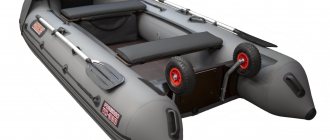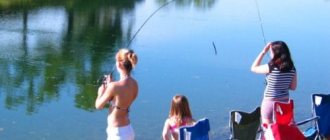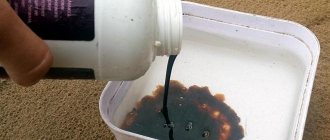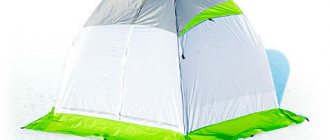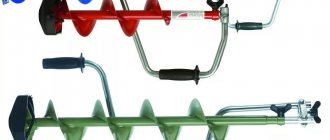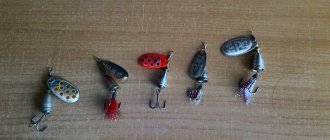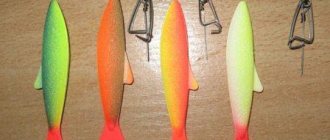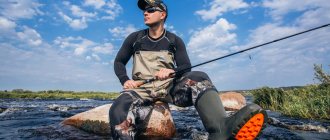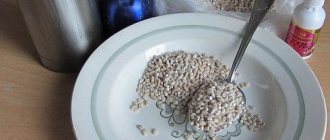What are anise drops used for when fishing?
Anise for fishing is often called a bite activator due to its effective attraction of the attention of prey.
Anise is found in fishing bags much more often than other attractants due to the cheapness of the drops and the effective bite. In nature, anise is a flower with a successful combination of microelements; it is used in the medical, culinary fields, cosmetology, and today it has become widespread in fishing. Anise oil drops have a number of advantages:
- strong, attractive odor;
- affordable price, the purchase will not hit the pocket of a fisherman with any level of income;
- economical consumption, add 1-3 drops to the bait.
Fishing in certain reservoirs is sometimes unsuccessful, since not all fish react well to this aroma. Sometimes the fish is full, it doesn’t like the composition of the mixture, or the time for fishing is simply chosen wrong, then you can’t count on an active bite.
To attract the attention of fish, fishermen often use anise drops.
https://youtube.com/watch?v=KwV6TXV4wTk
Ammonia-anise drops
Anise is a spice obtained by processing the annual plant of the same name. To prepare bait, you can use anise oil, pure or dissolved in ammonia.
You can buy ammonia-anise drops at any pharmacy.
A similar flavoring is used when preparing bait based on cereals, barley or wheat, which must first be soaked or ground, as well as from corn flour. Depending on the recipe, live food such as bloodworms or dried worms may be added to the bait.
When fishing in the summer, the weight of the added flavoring, ammonia-anise drops, of the total weight of the bait should be five percent. If we talk about winter bait, then the winter version of the recipe involves adding ammonia-anise drops. In winter, bait should contain a protein component, that is, live food, chopped dried worms or bloodworms, for example. The fact is that in winter fish experience greater hunger than in summer, so protein-rich animal feed is a must.
What products can anise drops be combined with? Anise harmonizes perfectly with the larva of the burdock moth. The fact is that the larva has a rather specific aroma, which in itself attracts fish, however, anise further enhances this effect, so that such bait can provide the fisherman with an excellent catch even on the most unsuitable days for fishing.
The bait with the addition of ammonia-anise drops should be stretchy, enough to form a small ball, which, when reached, will disintegrate and turn into a tasty and aromatic cloud that is attractive to fish.
What smells does crucian carp like?
The harmful and shy crucian carp has smells that it loves most:
- - This is a bait with pheromones (smell) that fish really love. Nothing artificial, all natural ingredients.
- vanilla. The smells of vanilla are most attractive to small and medium-sized crucian carp. But don’t be surprised if, together with this fish, you pull out a bream, which loves vanilla no less than its brother.
- Anise. It will be enough to add a few drops of anise oil to bread or semolina so that the crucian carp smells this smell. In winter, experts recommend either not using anise at all, or adding very little to the mixture.
- Garlic. Larger individuals most often react to garlic.
- Honey. Sometimes there are periods when crucian carp really want something sweet. Therefore, it is best to use natural honey. It can be mixed with semolina.
- Hemp. If the bite is very sluggish, then it will be effective to use hemp as bait.
- Dill. It is considered one of the best flavors for catching crucian carp, which hides in heavily overgrown reservoirs.
- Potato chips. These flavors are mainly used by carp, but small crucian carp are also often caught.
- Oat cookies. In order for such cookies to have better stickiness and attract crucian carp, a little flour should be added to it.
What smells do crucian carp like?
Flavorings are a kind of seasonings that improve the taste of the “dish” served to crucian carp. According to their condition, they can be in the form of:
- oils;
- syrup;
- spray;
- dry powder.
In addition, the wide variety of tastes and smells for fishing can be divided into 4 types:
- Caramel-cream. From the caramel-cream category, crucian carp prefers the aroma of chocolate, cookies, and milk.
- Nut. From this category, the best smells for fishing are considered to be hazelnuts, peanuts, and walnuts.
- Fruity. From the fruit category, the aromas of pineapple, melon, raspberry, strawberry, and plum are suitable for catching crucian carp.
- Spicy. Anise, vanilla, cinnamon, garlic, pepper, dill are suitable from the category of spices.
Flavorings can be in the form of a spray
Flavors can be purchased at special fishing stores or prepared independently using familiar products. The most popular flavorings used at home:
- anise;
- vanilla;
- carnation;
- hemp;
- cocoa;
- cinnamon;
- cake;
- essential oils;
- nuts;
- fruit juice;
- dill;
- fennel;
- halva;
- garlic.
You can make flavors from available products
Some fishermen, in addition to the above-mentioned flavorings, use special amino acids. They effectively influence the crucian carp, encouraging it to take the bait. These amino acids contain the following ingredients:
- calf liver;
- insects;
- animal blood;
- maggots;
- leeches;
- worms
Which of these aromas is the best for crucian carp? After all, he loves many smells, but some of them are the most preferred.
Anise
Traditional scent to attract crucian carp. It is most often added to semolina and bread, 1-3 drops each, which is quite enough to attract fish. Anise should make up 2-5% of the total weight of the bait. In winter, it is better to use anise powder in an amount of 2-3%. And in the summer - anise drops or oil, which should be added as much as possible, about 5%.
You can make the bait more attractive to crucian carp by adding anise to it.
Vanilla
This pleasant smell is very attractive to crucian carp. Powdered vanillin, vanilla sugar, and vanilla pods are suitable for catching it. In addition, sprays and drops with a vanilla scent are widely used. You can add vanillin to any bait - bloodworms, maggots, worms, semolina, bread. 30 g of vanilla sugar is usually enough to make 1 kg of groundbait or vegetable bait appetizing. Drops are applied directly to the nozzle, directly at the fishing site.
Hemp
An excellent additive for sluggish fish bites. It is advisable to add roasted and steamed hemp seeds to the bait. And for attachments you can use a hood. For many fishermen, this aroma is the main one for bait. It can be used throughout the year for fishing along with other flavors.
Honey
Crucian carp sometimes crave sweets, and he prefers the smell of honey. It is advisable to use only natural honey, adding it to semolina and pasta. Most often, honey is used for fishing in the warm season. But it can be very effective in cold water, especially together with other aromas.
You can improve the bite of crucian carp by adding honey to the bait
Garlic
The garlic aroma attracts crucian carp in most bodies of water, and large fish most often react to it. Therefore, when attracting crucian carp with the aroma of garlic, the fisherman automatically excludes small fish. You can add garlic to almost every bait, flavor semolina, dough and bread crumbs with it. Bait animals should also be dipped in squeezed garlic or treated with garlic spray. Very often this flavor is an additional component to vanilla, honey, caramel and fruit aromas.
Price
The price of the drug is its advantage. The price of a medicine depends on the appetite of the pharmacy chain and the manufacturer. The average cost in Russia ranges from 50 to 100 rubles. Here are examples in some regions for 2021:
- In Moscow and the Moscow region, drops cost from 70 to 100 rubles.
- In the Voronezh region the cost is from 54 to 80 rubles.
- In the Krasnodar region from 56 to 97 ₽.
- In the Tula region from 49 to 97 ₽.
- In the Lipetsk region from 50 to 80 ₽.
- In the Arkhangelsk region from 60 to 100 ₽.
- In the Irkutsk region from 56 to 90 ₽.
- In the Leningrad region from 59 to 120 ₽.
- In the Vladimir region from 118 rubles and above.
- In the Rostov region from 56-80 ₽.
- In the Vologda region from 68 ₽.
- In the Kaliningrad region from 63 ₽.
- In Crimea, the average cost is 77 ₽.
Store-bought flavors
Today, there are a large number of different attractants that are produced at the production level by different firms and companies, both domestic and foreign. They may have different industrial bases and technological equipment. Therefore, the production of flavors may differ not only in the form of delivery of the substances, for example, whether it will be granules or gel, but also in the packaging method, the presence of a branded label, and much more.
Moreover, entire research institutes, advanced and talented ichthyologists, professionals in fish physiology and biotechnologists can work for modern holdings that produce flavorings in especially large volumes. There are also companies that work closely with organizations producing baits or baits. This:
- Berkley;
- Sensas;
- Rublex;
- Yum;
- Bass Assassin;
- Gary Yamamoto and many others.
Small manufacturers that do not have a broad scientific base and technological equipment are engaged in the production of flavorings based on:
- dried animal blood;
- extracts from shrimp and other marine life;
- worms;
- cakes;
- milk powder;
- confectionery and pharmacological flavorings and additives.
If we compare purchased attractants with traditional ones, there is no huge difference between them. The former simply have a more convenient form of delivery in the form of a spray or gel, and have their own special packaging. But most importantly, they must be accompanied by instructions or recommendations for use. Holdings today are trying to produce flavors by chemical synthesis or biotechnology, which is considered more profitable from the commercial side.
Cough recipes with anise drops
The main way to use cough medicine is internally. The appropriate dose of the drug is preliminarily measured, which is diluted in 15 ml (1 tablespoon) of liquid - water, tea, compote, etc.
Instructions for use of ammonia-anise drops recommend consuming the product before meals. After swallowing the medicine, you must additionally take up to 200 ml of water. The liquid helps activate the secretory function of the mucous glands in the bronchi and accelerates the discharge of sputum.
For children, ammonia-anise cough drops are prescribed from the age of 12. High ethanol content negatively affects the body of a child under this age. In pediatrics, the drug is often combined with other herbal cough remedies - Alteyka, Doctor Mom, chest mixture and the like.
Dosage for children from 12 to 14 years old – 10-12 drops diluted in 15 ml of water three times a day.
For adults
The anise plant is a small rounded bush with straight stems just over half a meter high. The lower leaves of the plant are serrated and long-petiolate. The upper leaves are divided into three segments, but can be whole; the middle ones are wedge-shaped.
Anise has small white flowers of regular shape, which are collected in an umbrella inflorescence. On one stem, as a rule, there are several inflorescences of different sizes. From the ovary, an ovoid, two-seeded fruit develops, having a diameter of several millimeters and a length of about 4 mm.
The ripened fruit contains two seeds. The ribbed seeds of the plant are pear-shaped. Under natural conditions, the plant grows in the Middle East (Lebanon). To obtain useful seeds, the plant is cultivated in Asian countries, Mexico, Egypt, southern Europe, and Russia. In our country, large anise plantations are planted near Voronezh, Belgorod, Kursk, as well as in the Krasnodar Territory.
A natural medicine that has an expectorant, anti-inflammatory, laxative and antispasmodic effect.
The oil of this plant contains:
- methylchavicol – 10%;
- anethole – over 85%;
- camphene;
- a-pinene;
- dipentene;
- a-phellandrene;
- acetaldehyde;
- anisketon.
Each of them contains:
- Anise oil.
- Rapeseed oil.
- Gelatin.
- Water.
- Glycerol.
- Dye E141.
Before taking the medicine, dilute it with water so as not to burn the mucous membrane. The recommended dose is diluted in 100-150 ml of water. Take half an hour before meals 2-3 times a day, with plenty of warm drink (compote, tea, etc.). Coughs are usually treated for no longer than a week. How to take the medicine correctly is also indicated in the instructions.
Adults should take 10-15 drops at a time. Anise cough drops for children are prescribed only by a doctor. Children under nine years of age are prescribed one drop for each year of life. From 10 to 14 years old they give 10 drops, from 14 to 16 years old - 10-12 drops.
To prepare an effective cough remedy at home, use ammonia-anise drops and cough tablets based on the thermopsis herb. 2 tables thermopsis is ground into powder and poured into a glass. Add a teaspoon of drops and 2 tbsp. water. Take twice a day half an hour before meals, and the third time two hours before bedtime.
Anise drops can also be used effectively in other recipes. For example, they are mixed with syrup based on marshmallow root. This is how a medicine is obtained that is not inferior to expensive drugs made from synthetic components. Separately, decoctions and tinctures are prepared from anise seeds at home.
They are mixed with honey, licorice root or coltsfoot leaves and poured with hot boiling water. Drink warm until complete recovery.
Indications for the use of anise drops
Most often they are prescribed for coughs due to infectious diseases of the respiratory tract. Their most effective use is for dry cough. Treatment with ammonia-anise drops is allowed at any stage of the disease, during which sputum discharge is difficult. Their use at the first signs of the disease can to some extent prevent severe inflammation of the mucous membranes of the throat. Sometimes timely treatment can prevent the development of infection.
Main indications:
- bronchitis is an infectious disease of the bronchi, characterized by the accumulation of mucus in the bronchioles;
- tracheitis - inflammation of the trachea, the main symptom is a strong, paroxysmal cough;
- pharyngitis is an acute disease accompanied by inflammation of the tissues of the pharynx;
- whooping cough is an infectious disease of the respiratory system;
- laryngitis - inflammatory processes of the mucous membranes of the larynx, often the result of a long course of viral diseases;
- bronchogenic pneumonia - acute inflammation of the walls of the bronchioles.
Alternative uses
Drops improve the digestion process
Anise drops can also be used for other diseases accompanied by a dry cough. The latter most often occurs in the initial stages of the disease. This is due to irritation and inflammation of the throat mucosa; coughing in this case is a natural reflex to try to eliminate the cause of the sore throat. Subsequently, under the influence of anise oil, the sputum begins to disappear. After its complete disappearance, recovery begins.
Additionally, ammonia-anise drops have a positive effect on the gastrointestinal tract. With their help, the digestion process is improved, bloating is eliminated, and the secretory activity of the stomach is restored. The latter property is a contraindication to their use for peptic ulcers and some forms of gastritis.
Hemp as bait
If hemp seeds are boiled, it can be used as bait on a hook. The roach loves it very well, but you just need to use this attachment correctly: it is advisable to use it when there is no wind outside. This requires the use of very delicate tackle. Although the bite will be active, the probability of empty bites is very high.
Read DIY fish smoker
Delicate tackle should consist of a very small hook, an equally small sinker, no more than 5g, and a very light float with a thin antenna. To attach the bait to the hook, you should select larger grains, and leave the smaller ones for bait.
Since hemp seeds do not grow to a size where they can be hooked the same way as peas, the process is quite complex and does not guarantee that the hemp seed will get to the bite. There is a high probability that it will fly off.
Many fishermen put black pellets, similar to hemp grain, on the hook, and use hemp grains for bait. Using this fishing technique, you can catch roach or chub.
Anise drops for bait
As mentioned above, anise drops are an excellent flavoring agent for attracting fish, however, as in many other cases, you should not overdo it.
The content of anise drops in the bait should not exceed five percent, but not less than two.
Anise drops for bream
Bream is a predatory fish that prefers animal food. So when using anise to prepare bait, it is best to add more animal feed.
Anise drops for crucian carp
Crucian carp really love the aroma of anise, so in order for catching this fish to be successful, you need to add a small amount of drops to the feeding mixture and moisten the bait.
Barley and anise drops
Just like any other cereal. Barley goes well with a flavoring such as anise. So you can safely mix these two ingredients into a single mixture.
Bread crumb and anise drops
Anise drops and bread crumb, especially rye bread, which itself has an attractive aroma for fish, go well together. When preparing bait, you need to moisten and knead the crumb, and then lubricate it with anise drops.
Sweet dough and anise drops
Some fish are very fond of sweets and a sweet smell, so it is fashionable to use a piece of sweet dough, smeared with anise drops, as bait.
Dough with garlic and anise drops
A piece of dough, which contains garlic and anise drops, is an excellent bait for fish, because like anise, garlic has an attractive aroma, which attracts fish to the fishing spot. There she may well swallow the bait.
Pellets and anise drops
Spools are bait attached to a hook. Rolls are made from corn, wheat, pea or semolina, which should be moistened with water.
A small amount of anise drops should be added to the water. In this case, anise lures the fish with its pleasant aroma, as a result of which it gets hooked when trying to swallow the bait.
Oatmeal and anise drops
Oatmeal is ground, pre-roasted cereal grains. Often these are oats and barley. Oatmeal is mixed with anise drops and water.
If bait is made, then the mixture is rolled into a ball and dropped to the bottom of the reservoir, and if bait is used, then a spool is formed from it, which is subsequently placed on a hook. The content of drops in the composition of groundbait or groundbait should not exceed five percent.
Anise oil
On the shelves of fishing stores you can actually find a lot of different essences that are used in the process of preparing bait. For example:
- Apple essence.
- Barberry essence.
- Pear essence.
- Banana essence.
- Raspberry essence.
- Anise essence.
- Currant essence.
- Strawberry essence.
Anise oil may be quite rare compared to the others included on the list. Despite this, it is precisely this that is able to distinguish the bait from the many baits of other fishermen.
Ammonia-anise drops
To provide yourself with this type of flavoring, it is enough to plant anise in your country house or garden. This plant is unpretentious, so there should be no problems with its cultivation. Subsequently, it will be possible to prepare ammonia-anise drops from anise seeds, providing yourself with a catchy flavoring. At the same time, it is not necessary to prepare them for the future, but it is enough to prepare them for the next two weeks.
How are anise drops used?
Anise drops are mainly used for preparing groundbaits based on cereals and corn flour. In addition to anise drops, bloodworms or chopped dung worms are added to this composition. This approach is only promising if fishing is carried out in spring or autumn. During these periods, fish prefer high-calorie animal foods.
TOP 10 Attractants for fishing for crucian carp, carp, roach. Do-it-yourself attractant for fishing
Anise bait recipes
Anise, as a bait for fish, requires the correct selection of mixture components; aroma alone is not enough to obtain a large catch. First of all, it is better to check whether the fish in the reservoir is going for anise by making a test cast of the bait. If there is no reaction from the aquatic inhabitants, add a little flavor.
How to use anise as a bite activator to catch bream:
- Take breadcrumbs or grind regular dried bread.
- Grind the shell rock.
- Cook the peas and mix with the general mixture.
- At the same time, cook the corn, then add it to the mixture.
- If desired, we add maggots or bloodworms.
- Mix the composition and add drops of anise 1 to 20.
- Mix the mixture again and form balls that fit completely in the palm of your hand.
Dough recipe with garlic and anise drops:
- Mix the drops with corn oil in a ratio of 1 to 20.
- Squeeze the garlic juice into the oil.
- Knead the dough with the addition of the listed oils.
- Let the dough stand for 1 hour.
- Boil the potatoes, peel them when ready and mash them.
- Mix the dough with the potatoes and place in a disposable bag.
- Add butter and flour to create the right consistency.
Recipe with pearl barley:
- Boil water (should be 1 to 5), grind the anise seeds to a powder, then pour it into a pan with boiling water.
- Add pearl barley to the water and stir the mixture little by little.
- Cook over low heat for about 15 minutes.
- As additional ingredients we can add hemp, whole anise grains and roasted sunflower seeds.
If you have the opportunity to be on a body of water in advance, it is better to pick berries near the headquarters or the river. We add them when they are ready; the fish is familiar with their smell, which improves the catch.
Originally posted 2018-07-31 07:51:27.
Bait recipes using anise
There are a large number of different recipes that use anise. Below are the most popular and effective ones.
- Prepare the base, it can be pea, barley, corn or wheat cereal. You can also mix them;
- Grind the cereals in a blender;
- Boil the cereals;
- Add corn flour;
- Add anise drops;
- Mix to form a viscous mass.
- Grind the crackers in a blender;
- Chop the shell rock;
- Boil peas;
- Mix breadcrumbs and peas with pickled corn;
- Add shell rock to the resulting mixture;
- Add anise drops in a concentration of 1/20 and mix.
This recipe is best suited for baiting bream.
- To boil water;
- Add crushed anise seeds to water;
- Add pearl barley, stirring a little. The ratio of water and cereal should be 1:5;
- 15 minutes before readiness, you can additionally add whole anise seeds;
- Cook for about 20-30 minutes over low heat.
This method will be useful when catching crucian carp.
When cooking this complementary food, it would not be a bad idea to add berries that grow on the shore of a reservoir.
- Dip bread in milk;
- Add egg yolk;
- Knead the dough from this mass, gradually adding unrefined oil;
- Add a teaspoon of anise drops to the dough;
- Tint the dough with dye.
This bait is suitable for catching carp or other fish of the same family. If the dough falls apart when placed in water, you can add a little cotton wool to it.
- Mix anise drops and sunflower oil 1:2;
- Squeeze garlic juice into the resulting mixture;
- Mix the resulting mixture with wheat flour;
- Leave for about 2 hours;
- Boil the potatoes;
- Mash the boiled potatoes;
- Mix potatoes with dough;
- Place this mass in a plastic bag;
- Stir until required consistency.
- Take a glass of flour;
- Add anise drops, eggs and sugar;
- To fill with water;
- Knead the dough;
- Divide the dough into small pieces;
- Roll the pieces into balls;
- Place on the table and let them sit for about 30 minutes;
- Thread the spools onto a thread (to do this, you need to make through holes in the balls using a needle);
- To boil water;
- Cook until the pellets float to the surface;
- Hang the thread with the balls and let them dry completely;
- Cut the thread and tie it into two knots.
It is better to dry the pellets in the shade; under the influence of the sun they can dry out and crack. You can also process the balls without boiling water; you can simply fry them in the microwave.
Important! It is necessary to dry the pellets longer to avoid mold during storage.
- Soak oats for 3 hours;
- Rinse;
- Pour in clean water and cook for a while over low heat;
- Immediately before use, soak in anise.
Important! Under no circumstances should grains be overcooked. If you overcook them, they won't stay on the hook.
When making bait according to any of these recipes, you can additionally add sugar or honey. Since many fish love sweets, this will enhance the effect of anise.
This attractant is a product that is suitable for all fishermen. Its shelf life is approximately 2 years. The price is 30-40 rubles, you can buy it either at a pharmacy or at a fishing store.
Broncho Theiss
Drops for oral use. 30 ml in a dropper bottle in a cardboard box.
1 g of solution (24 drops) contains 50 mg of star anise oil, 250 mg of Extract Thymi fluid (1: 2 - 2.5), extractant: ammonia solution 10% / glycerin 85% / ethanol 90% / purified water (1/20/70/109)
Store in original packaging at a temperature not exceeding 25 ° C. Shelf life - 3 years.
Broncho Theiss has an expectorant, pronounced mucolytic, bronchodilator effect. Broncho Theiss drops contain star anise oil and liquid thyme extract. Anise oil has secretolytic, antispasmodic, secretomotor and antibacterial effects; in high concentrations it has an antifungal effect. Thyme extract has a bronchospasmolytic and expectorant effect.
Indications for use. Symptomatic treatment of inflammatory diseases of the respiratory tract, accompanied by cough and difficulty producing thick sputum (tracheitis, bronchitis, tracheobronchitis).
No cases of overdose were observed. Internal intake of anise oil from 1 to 5 ml was associated with nausea, vomiting, convulsions, and pulmonary edema.
Broncho Theiss should not be taken during pregnancy or while breastfeeding.
When using the drug Broncho Theiss, allergic reactions are possible, including rash, itching, hyperemia, urticaria, angioedema, anaphylactic shock, shortness of breath, bronchospasm, gastrointestinal disorders, including spasms, nausea, vomiting, diarrhea.
Broncho Theiss drops are contraindicated in case of hypersensitivity to the components of the drug, to other plants of the Lamiaceae or Umbelliferae family (fennel, cumin, celery, coriander, dill), to birch pollen (cross-reaction is possible) or to ethanol, during pregnancy, during breastfeeding, in children under 4 years of age, children with a life history of acute stenosing laryngotracheitis, asthma.
With caution: alcoholism, epilepsy, severe liver dysfunction, brain diseases and injuries. Broncho Theiss drops contain 48% ethanol
This must be taken into account when driving vehicles or operating other mechanisms.
Broncho Theiss drops contain 48% ethanol. This must be taken into account when driving vehicles or operating other mechanisms.
If during treatment the symptoms worsen and/or shortness of breath, fever or purulent sputum appear, you should definitely consult a doctor.
If symptoms persist after one week, you should consult your doctor.
If you need to use any other medicines at the same time, consult your doctor.
Below are drugs with the same ATC code of level 3 or 4, or the same pharmacotherapeutic group. Before replacing a drug with an analogue, be sure to consult your doctor!
- Alteyka: price, instructions
- Anise oil: price, instructions
- Bronchofit: price, instructions
- Gederin: price, instructions
- Doctor Cough: price, instructions
- Mukaltin: price, instructions
- Ammonia-anise drops: price, instructions
- Pectoral: price, instructions
- Pectusin: price, instructions
- Pertussin: price, instructions
- Plantain: price, instructions
- Prospan: price, instructions
- Licorice root: price, instructions
- Pine buds: price, instructions
- Altemix: price, instructions
- Ingalin: price, instructions
- Pluforkaf: price, instructions
- Althea root: price, instructions
- Ledum: price, instructions
Bronchostop: price, instructions
Oregano herb: price, instructions
Macrotussin: price, instructions
- Soledum: price, instructions
- Tavipek: price, instructions
- Tussin: price, instructions
Thyme herb: price, instructions
Instructions for use, composition, side effects and other detailed information on this page, for ease of understanding, are provided in a free translation of the manufacturer's official instructions. This material is for informational purposes only. We are not involved in the production or sale of drugs. Remember: the need to use the drug, methods and doses are determined only by your attending physician. Self-medication can be dangerous to your health!
Read Where is the best place to dig worms for fishing?
What kind of fish can you catch with anise?
It is often recommended to use anise when fishing for all peaceful fish, but it is better to use it when hunting for crucian carp and bream, for which anise drops show impeccable results. When fishing for bream, drops are added very often, since other forms of the substance bring less results.
To increase the amount of catch, it is important to choose favorite places for bream: shell rocks, pits, etc.
Anise drops, which are used for fishing, do not always bring a good catch. We recommend trying the method on the selected reservoir, but if there are no bites, it is better to use clean bait without any aromatic additives. Comparing the effectiveness of casting will help determine the feasibility of using droplets.
Crucian carp reacts poorly to the smell of ammonia; the use of drops is ineffective and often drives the fish away from the feeding area. When chasing crucian carp, it is better to use water-based drops or anise oil. If the attractant was prepared at home, it is better to boil the bait in the water left over from preparing anise seeds.
Bream responds very well to the smell of anise.What kind of fish bites on anise?
Bait containing anise - what fish is it suitable for?
This question worries many fishermen. The answer is simple: it can be used for different types of fish, but bream and crucian carp are considered to be the most susceptible to this attractant. Important! Anise may not be to the taste of some fish. To determine this, you need to try using bait with this attractant, and then use the bait in its pure form
For bream it is best to use anise drops
It is important to remember that bream choose shell rocks as a feeding place. This is where you should start trial fishing.
During test fishing, you don’t need to spare the drops, but it’s better to save the bait.
For crucian carp, it is not recommended to use drops based on ammonia, because ammonia has a strong odor, which can scare off crucian carp. It is best to use alcohol-free drops or anise oil. It is better to prepare bait for crucian carp in water in which anise seeds have been boiled.
These simple tips will help you use anise most effectively, saving the fisherman time and money.
How to use anise drops?
They are added mainly to groundbait, flour and corn. This is one of the most effective combinations. Also, live food, such as bloodworms or worms, is often added.
There are several options for using this flavor.
Anise drops for bait
To make bait that will be especially popular with fish, with the addition of such a substance, you must complete the following steps:
- Choose cereal for the base, it can be pure cereal (barley, wheat), or a mixture of cereals (pea, corn, pearl barley)
- Grind the selected grain
- Boil until done and add some cornmeal
- Add anise flavoring in a ratio of 1 to 20
- Stir well until the mixture can be formed into balls that will not disintegrate when hit with water.
In summer, you can add a little more anise drops so that when the bait hits the water, they create a fragrant cloud that will attract the desired catch. In winter, slightly reduce the percentage of the additive in relation to the total weight of the bait.
Anise drops for bream
To catch bream, first of all, you need to choose the right place, see if the fish swim to it in search of food. During test fishing, you should not throw a lot of bait; it is better to increase the amount of flavoring, in our case, anise.
To prepare bait for bream, you must complete the following steps:
- Take bread crumbs and chop them finely, grind them to crumbs.
- Grind the shell rock
- Boil peas and add to mixture
- Take some boiled corn
- You can use maggots, add them to the bait
- Mix all ingredients thoroughly and pour in anise drops, about 1/20 of a bottle
- Mix well again and form small balls that you will throw into the water.
Anise drops for crucian carp
This flavoring is used to attract fish such as crucian carp. But, there is no need to take ammonia-anise preparations, since the ammonia contained in them will scare away the fish. Crucian carp really love this smell, so you can use drops in any bait composition, and even wet the bait in them.
Fishermen say that complementary feeding is quite effective when it is done not with plain water, but with water in which anise seeds have been boiled.
How to make anise drops for fishing with your own hands?
You can easily make this flavoring yourself at home. To do this you need to take:
- Anise seeds
- Ammonia
- Coffee grinder or any other grinder
- Gauze
To prepare anise drops at home you need:
- First, grind the anise seeds and pour them into ammonia
- All this must be infused for at least one day.
- After they have infused, use gauze to strain the infusion, getting rid of particles of seeds.
- That's it, the anise drops are ready.
Best before date
The expiration date is indicated on the drops label. This is approximately several years from the moment the package was opened. But, if you prepared anise drops at home, then if properly stored in a cool place, they will last only a few weeks. This is due to the fact that they did not undergo the necessary heat treatment, and bacteria will still multiply.
Simple bait recipe
You can make your own bait with hemp as follows:
- Take hemp seeds and rinse well.
- Place the seeds in a bowl and add water, then leave them for a day.
- The seeds will be ready as soon as they sink to the bottom.
- After this, the cannabis is placed on the fire and cooked for half an hour.
- As soon as the grains begin to shoot white tongues, they are ready.
- Take as much grain as you need, and the rest can be put in the freezer.
Of course, it is used as bait from mid-July to mid-September, although many fishermen use it regularly and do not go fishing without hemp, especially when they realized how effective it is. If you use hemp itself for bait, constantly throwing it to the float, then you need a lot of it, and using such an effective product in such quantities is not entirely rational.
How to prepare your own roasted hemp for bait
The cooking technology is very simple, you just need a frying pan and fire. To begin with, the required amount of hemp is poured into the frying pan and the seeds begin to fry over low heat. At the same time, you should constantly stir the seeds so that they do not burn. As soon as the seeds begin to crackle, they should be removed from the heat, allowed to cool and then grind them in a blender or coffee grinder.
Roasted hemp not only additionally attracts with its unique smell, but also with its behavior in water. Once in the water, small particles of cannabis begin to rise, which can also attract fish. As a rule, it is enough to add no more than 10% hemp seeds to the main bait to make the bait super catchy.
However, you should know that processed hemp seeds do not last long, unlike unprocessed ones. Therefore, it is advisable to take only fresh seeds for bait, otherwise there is a risk of not attracting the fish’s interest, but of scaring them away.
Anise drops for fishing
Anise is an annual plant that has been used as a spice since ancient times. For baiting fish, which in many ways ensures an excellent bite, anise oil is most often used.
There are many reasons for this, the most important of which is the relatively low cost of anise itself and its processed products.
The reasons for the low cost of such a spice as anise are the ease of cultivation and cultivation. Anise is a fairly unpretentious plant that does not require any special conditions.
Anise also has a subtle and delicate aroma, which is pleasant to humans and attracts fish. The subtle aroma of the spice attracts fish, which ensures productive fishing.
Anise is used to prepare groundbait in the form of drops, which can be either an essential oil prepared from this plant or an alcohol solution containing about fifteen percent anise oil.
In addition, the seeds of this plant or powder from them can be used.
To prepare bait for summer fishing using anise, you should use plant products such as various cereals and corn processing products.
It is also fashionable to add animal food, for example, dried worms or bloodworms. The concentration of anise in the form of drops, seeds or powder should be between two and five percent in the case of anise drops.
This amount of flavoring is quite enough to attract fish with a pleasant smell and interest the bait placed on the bottom.
If powder is used to prepare bait, the content of anise flavor in the composition should vary from two to three percent of the total mass of the mixture.
To prepare bait for winter fishing, it is necessary to use not only plant food, cereals, for example, but also bloodworms, worms, etc. The fact is that in winter the fish are hungry, so animal food mixed with such an attractive flavor as anise.
If we talk about bait for attracting fish in autumn and spring, then they are not much different from summer and winter, except that they can be something in between.
If we talk about the compatibility of ingredients, then anise in the form of essential oil or powder is best combined with burdock moth larva, as well as with cereals ground in coffee grinders
Before mixing the cereal with anise, it must be moistened so that it easily rolls into a lump. Water gives the mixture viscousness and prevents it from spreading over a long distance.
The mixture is dropped to the bottom in a container or rolled into a ball and dropped to the bottom with a simple throw. If the bait has been previously wetted, it will begin to decompose only when it touches the bottom, resulting in the formation of a fragrant and appetizing cloud, which attracts fish.
When baiting fish, you want to attract them, not overfeed them, so don't prepare too much bait.
What are anise drops for fishing?
Anise is a plant that has been used as a spice for quite some time. To enhance the smell of bait, anise drops are usually used, because their price is low and accessible to everyone. This plant itself is cheap due to the fact that it is easy to grow and cultivate. It does not require much attention or special conditions for growth.
This preparation has an incredibly delicate and pleasant aroma not only for humans, but also for fish. Its smell attracts individuals, and thus ensures a good catch.
They are very often added to bait. Can be taken in the form of essential oil or alcohol solution. It is also effective to use anise seeds, which are ground into powder. The concentration of this flavoring should not be more than 2-5 percent of the total weight of the bait. This is quite enough to create the desired aroma.
Anise oil
Anise oil is made from all parts of the plant by steam distillation. The result is a clear or slightly yellowish liquid. This oil is very popular, it is used in various fields: cooking, medicine, cosmetology.
This is because, in addition to its pleasant aroma, anise has unique properties that are beneficial to the human body. The oil from this plant has one peculiarity - it does not harden even at very low temperatures.
Advantages and disadvantages for fishing
This product, like any other, has its advantages and disadvantages. The main advantage is the strong smell, which the fish really like. Also, their price is very low, so every fisherman can buy and try. To make the bait more tempting, a few milligrams are enough.
It would seem that anise drops have no disadvantages, but one problem may arise. They may not always be effective. The reasons for this can be different: either the fish is not hungry, or the time is not right, maybe the bait itself was not to your liking. But sometimes experienced fishermen write that even with the addition of this substance to the bait, there is still no bite.
Plant flavors and bite activators. Classification and use
For successful fishing, it is necessary to add flavorings and bite activators to complementary foods. These are additives that are not food, but only help increase appetite - oriental spices, oils and seeds of umbrella plants. They are added in small quantities, the percentage in complementary foods ranges from 5 to 7%.
Read Do-it-yourself bottom tackle
Let's look at the most popular and effective additives to stimulate the appetite of fish.
Garlic
Dried garlic is loved by bream and carp. On warm summer days, up to 5% garlic is added, and on cold days - 2%. To catch crucian carp, a liquid garlic flavor is used. To prepare it, you need to take two garlic cloves, mash them and pour a glass of hot water, leave for 6 hours. The resulting infusion is added for mixing at the rate of 2 kg of complementary feeding mixture.
Anise
Anise can be used all year round, but in winter - in a concentration of no more than 3%. It is added in powder form to enhance the bite of roach, bleak, bream, tench, and carp. The nutritional value of anise powder is low, as is that of garlic powder. In stagnant water - ponds, lakes - complementary foods with the addition of anise are especially good at attracting crucian carp.
Licorice root
Liquorice is better known as licorice naked or Ural. The plant belongs to the legume family. Powder from its root is freely sold in pharmacies. It is used as an activator for catching all types of fish from summer to autumn; tench and roach especially love its smell. In hot weather, you can use a higher concentration of anise - up to 5%.
Star anise fruit
Other names for the fruit are Siberian, star, Indian, and Chinese anise. Ground star anise fruits are effective for increasing the bite of all peaceful fish. Its fruits are collected from trees that grow in Cambodia, Vietnam, China, and Abkhazia.
The taste of star anise is bittersweet, the smell is aniseed, but not cloying, since the fruits do not contain safflower oil. In terms of its action, the use of star anise gives better results when catching bream and roach than anise in any water - still or in a current.
Cinnamon
Cinnamon is the bark of trees that grow in southern India and Sri Lanka. It is added to complementary food for biting bream and roach.
Cinnamon is one of the best bite activators and flavors; it greatly stimulates the appetite of fish, regardless of the place of fishing and seasonality.
A substitute for cinnamon is freshly roasted ground coffee beans, but you need to add them in smaller quantities. Coffee powder is used only in summer in clean water bodies and in the current.
Fennel
Fennel is a medicinal perennial that belongs to the umbrella plants and is cultivated all over the world. Cake and oil are used for food. It is actively used as a component of bait to enhance the bite of bream. As practice shows, this is one of the strongest activators. To enhance the effect, it can be mixed with vanilla powder.
Turmeric
Turmeric, a herb belonging to the ginger family, contains a high concentration of essential oils and curmin, a yellow dye. Dried roots and stems are used for grinding.
These properties of turmeric are ideal for catching roach. The plant powder is added to complementary foods as a natural dye in a concentration of up to 15%.
The addition of turmeric gives good results when fishing for peaceful small fish on small and medium-sized rivers in the summer.
Dill, basil
Ground dill and basil are the best bite activators and go well with cinnamon. Used for catching crucian carp in muddy, overgrown reservoirs. Basil can be combined with all other bite activators; it is used to catch all peaceful fish. In addition to the stems, ground dill and basil seeds are used.
Cassava
Cassava is a shrub that grows in the American tropics. Its roots are highly poisonous and contain a lot of starch. Root vegetable flour is used to bake bread. Flour from this plant is added to the bait. Small things like bleak and roach bite well on this activator.
To enhance the effect, flavors and bite activators can be mixed. Cinnamon with coriander, basil, vanilla and cocoa powder make good combinations.
When mixing all flavor enhancers, you should always adhere to the following rules:
- - do not use related activators, as they are interchangeable. For example, if anise is added to complementary foods, then star anise should not be added there;
- - do not combine garlic with sweet activators. It goes best with basil, anise, and star anise.
Thus, flavorings and bite activators serve to attract fish to the place of complementary feeding, and keep them in place - the main food and additional components. They add nutritional value and stickiness to complementary foods. Additional ingredients include roasted peanuts, flaxseeds, potato chips, cookies, and pumpkin seeds.
Alternatives to Anise Drops
We have prepared for you a special article dedicated to the production of flavors, as well as the selection of ready-made solutions that are available in fishing stores. Read more.
, you can use sweet flavorings to prepare bait
when catching roach Among these flavorings are coriander, which tends to increase the activity of roaches, and vanilla (with a clean smell; you should not use store-bought vanillin , as it tends to be bitter). Vanilla can also be used as a flavoring agent for carp fishing This scent is best suited for summer fishing. In the case of catching this particular fish, you can use not only pure flavor, but also a mixture. The fact is that there are vanilla-based flavors with the addition of fruit aroma. In addition, when preparing bait for carp fishing, you can use fruit flavors such as peach, banana, plum, strawberry and pineapple. There are even more exotic scents, however, they are used less frequently. Honey is also suitable for feeding carp. They are more suitable for fishing in the summer, however, they can also be used for winter fishing. Flavors such as hemp and garlic (in combination with other flavors) are suitable for winter fishing. For catching crucian carp, flavorings such as vanillin (you need to add just a little, 2-3 crystals). In addition, ground dill or caraway seeds and garlic can be used as a flavoring agent for preparing bait for catching crucian carp (since it has a strong specific odor, so it needs to be added in small quantities). onions fried in oil to prepare bait , which also has an appetizing smell for crucian carp. Fish such as bream love the smell of coriander, which has a rather strong, but still pleasant smell. To prevent the smell from dissipating, you need to add ground coriander seeds a few hours before fishing. sunflower, flaxseed, dill and caraway seeds are suitable for fishing . To prepare bait, you need to take two or three tablespoons of seed, grind them and mix the resulting powder with all the other ingredients. Perch is a schooling fish that is most attracted not by flavor, but by the natural aroma of live food: bloodworms, worms , etc. For preparing bait for catching this fish, burdock moth larva , which has a pronounced aroma.
You need to mix live food with a base of ground cereal or flour, moisten it and form the bait into a ball, which must be lowered to the bottom of the reservoir. Using a fishing secret such as anise drops can significantly improve the results in catching fish, but you need to use it carefully, do not overdo it.
Finally, a very interesting video that describes the process of making artificial bait/bait, which is impregnated with flavors. Let's look:
Good luck in your fishing!
Flavors for crucian carp
Many people consider making their own flavor a real pleasure. And this is true, but you need to know some secrets, and also take into account many factors: features of the fishing location, season, the presence of neighboring fishermen, etc.
Favorite smells of crucian carp
What smells does crucian carp prefer? Experience, experiments and centuries-old observations of fish behavior have helped to find many interesting and even extreme recipes. In addition to traditional black bread, garlic powder, dill, and sunflower oil, crucian carp responds well to the smell of dung worms. However, you need to keep it in a box with mint, then it will become especially tempting for this fish.
One of the unexpected finds for catching crucian carp is the famous “Star” ointment. In order not to “bother” too much, you just need to smear your hands with this fragrant potion and knead dough, bread or other bait with it - the result is guaranteed! Other unusual options for crucian carp include kerosene, which, according to fishermen, gives excellent results.
Standard dips for crucian carp: anise, cocoa, vanilla and honey. Bait such as sunflower oil applied to corn grains works well.
It is imperative to use flavorings for baiting fish, experimenting with various additives. Baits that can be used are ground oatmeal cookies, toasted sunflower seeds or rolled oats porridge. The main thing is to make the right feeding, which does not fall into pieces, so that instead of fishing you do not give the fish a free feast at the bottom.
WHERE TO BUY AND HOW MUCH ARE ANICE DROPS
Anise drops can be purchased either at a pharmacy or at a fishing store. One package costs about 30-40 rubles, and their volume is enough for 2 whole years.
On the other hand, you should not get too carried away with attractants, especially those of chemical origin. Dosages must be strictly observed, otherwise the effect of their use may have a retroactive effect. Instead of luring the fish, you can simply scare them away with the strong aroma of anise drops or other attractant.
You can buy anise drops not only at the pharmacy, but also in stores specializing in the sale of essential oils. Alternatively, drops can be purchased at points of sale of accessories for bathhouse lovers, as well as in fishing stores. The price of one package reaches 30–40 rubles, and the purchased volume will last you for a couple of years.
You should not hope for a miracle from using anise drops as an attractant; pour liters of it into groundbait and groundbait. It is worth remembering that first of all it is necessary to make experimental casts with soaked bait and find out how the fish like it, and only then add it to the main bait.
Best before date
Self-preparing anise drops does not imply their long-term storage. This is due to the insufficiency of their chemical and thermal treatment. In this regard, you should not prepare many drops at once. You need to prepare enough to last for a couple of weeks of successful fishing.
After this period they will become unusable. Store-bought anise drops can be stored for a couple of years after the bottle has been opened.
